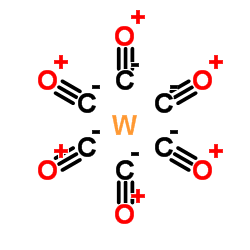六羰基钨

六羰基钨结构式

|
常用名 | 六羰基钨 | 英文名 | Carbon monooxide-tungsten (6:1) |
|---|---|---|---|---|
| CAS号 | 14040-11-0 | 分子量 | 351.901 | |
| 密度 | 2.65 g/mL at 25 °C(lit.) | 沸点 | 175 °C | |
| 分子式 | C6O6W | 熔点 | 150 °C(lit.) | |
| MSDS | 中文版 美版 | 闪点 | 200°C | |
| 符号 |

GHS06 |
信号词 | Danger |
|
Surfactant-free synthesis of plasmonic tungsten oxide nanowires with visible-light-enhanced hydrogen generation from ammonia borane.
Chem. Asian J. 10 , 1291-4, (2015) WO3-x nanowires were successfully synthesized through a simple surfactant-free solvothermal method. These nanowires exhibit strong plasmonic absorption in the visible and near-infrared region owing to the abundant oxygen vacancies. The plasmon excitation of t... |
|
|
Highly scalable, atomically thin WSe2 grown via metal-organic chemical vapor deposition.
ACS Nano 9(2) , 2080-7, (2015) Tungsten diselenide (WSe2) is a two-dimensional material that is of interest for next-generation electronic and optoelectronic devices due to its direct bandgap of 1.65 eV in the monolayer form and excellent transport properties. However, technologies based o... |
|
|
The transient electrical conductivity of W-based electron-beam-induced deposits during growth, irradiation and exposure to air.
Nanotechnology 20(19) , 195301, (2009) W-based granular metals have been prepared by electron-beam-induced deposition from the tungsten hexacarbonyl W(CO)(6) precursor. In situ electrical conductivity measurements have been performed to monitor the growth process and to investigate the behavior of... |
|
|
Millisecond pulsed radio frequency glow discharge time of flight mass spectrometry: temporal and spatial variations in molecular energetics.
J. Am. Soc. Mass Spectrom. 15(1) , 87-102, (2004) The internal energy distributions, P(epsilon), of a millisecond pulsed radio frequency glow discharge plasma were investigated using tungsten hexcarbonyl W(CO)(6) as a "thermometer molecule". Vapor of the probe molecule, W(CO)(6), was introduced into the plas... |
|
|
Mechanism of W(CO)6 sonolysis in diphenylmethane.
Ultrason. Sonochem. 19(3) , 498-502, (2012) The present work analyses the mechanism of W(2)C/C nanocomposite formation during sonolysis of W(CO)(6) in diphenylmethane (DPhM) solutions. Carbon supported WC(x) nanoparticles attract much interest as an alternative fuel cell electrocatalysts. Sonolysis of ... |
|
|
Determination of Ni(CO)4, Fe(CO)5, Mo(CO)6, and W(CO)6 in sewage gas by using cryotrapping gas chromatography inductively coupled plasma mass spectrometry.
J. Environ. Monit. 1(1) , 33-7, (1999) Evidence for the occurrence of Ni(CO)4 in addition to Mo(CO)6 and W(CO)6 in fermentation gases from a municipal sewage treatment plant is presented for the first time. The gases were sampled at the top of the sewage sludge digester using Tedlar bags, and were... |
|
|
Preparation of hydantoins by catalytic oxidative carbonylation of alpha-amino amides.
J. Org. Chem. 74(22) , 8862-5, (2009) Hydantoins can be synthesized from the corresponding amino amides employing oxidative catalytic carbonylation using W(CO)(6) as the catalyst, I(2) as the oxidant, CO as the carbonyl source, and DBU as base. Secondary amides afford the hydantoins in good to ex... |
|
|
Catalytic carbonylation of functionalized diamines: application to the core structure of DMP 323 and DMP 450.
J. Org. Chem. 68(4) , 1615-7, (2003) W(CO)(6)-catalyzed carbonylation provides an alternative to phosgene or phosgene derivatives such as 1,1-carbonyldiimidazole (CDI) for the conversion of amines to ureas. As an illustration, the core structure of the HIV protease inhibitors DMP 323 and DMP 450... |
|
|
Excitation and dissociation of tungsten hexacarbonyl W(CO)6: statistical and nonstatistical dissociation processes.
J. Chem. Phys. 134(3) , 034304, (2011) We have studied the excitation and dissociation processes of the molecule W(CO)(6) in collisions with low kinetic energy (3 keV) protons, monocharged fluorine, and chlorine ions using double charge transfer spectroscopy. By analyzing the kinetic energy loss o... |
|
|
Convenient synthesis of palladium nanoparticles and catalysis of Hiyama coupling reaction in water.
Org. Lett. 9 , 3639, (2007) An efficient synthesis of Pd nanoparticles in water has been developed using a Fischer carbene complex of tungsten as the reductant and PEG as the capping agent. The colloidal palladium (1 mol %) efficiently catalyzes Hiyama cross-coupling reactions performed... |